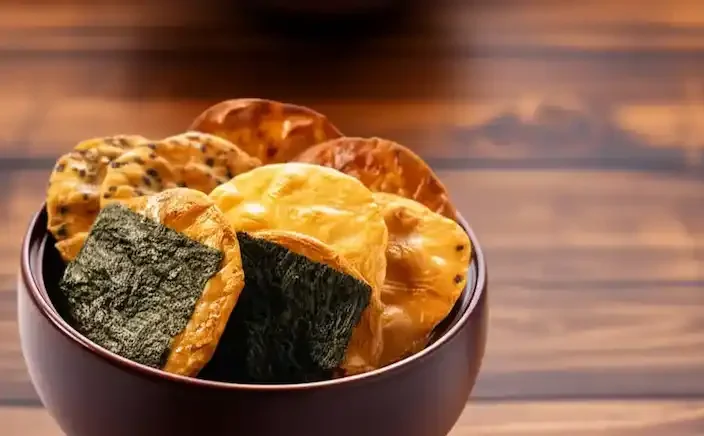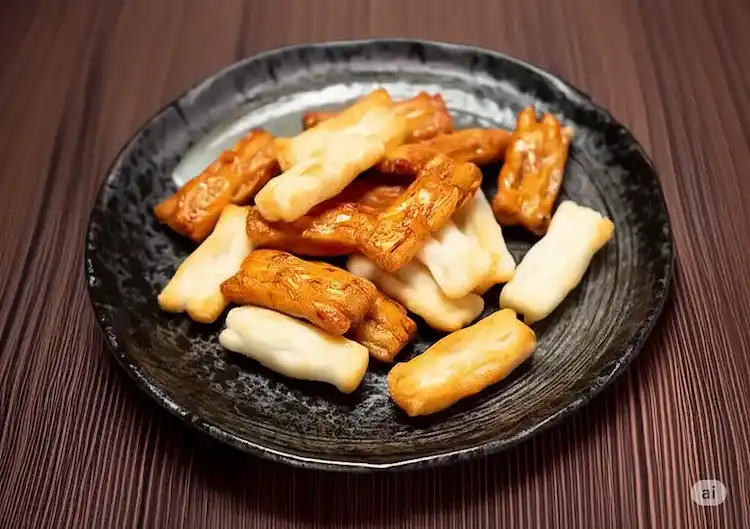Delicious, Historic, and Surprisingly Healthy World of Japanese Rice Crackers!
Take a bite, and you’re met with a satisfying crunch and a fragrant aroma.
These are traditional Japanese snacks, often enjoyed with freshly brewed green tea.
We’re talking about okaki, senbei, and arare. More than just simple snacks, they are like a mirror reflecting Japan’s rich food culture and history.
In this article, we’ll delve into the charms of these representative Japanese rice crackers.
We’ll unravel their differences, their ancient history, their surprisingly little-known health benefits, and even tell you where you can easily enjoy them.
So, let’s embark on a journey into the profound world of Japanese rice crackers together.
There must be a reason why these rustic rice crackers continue to be loved in Japan, a country known for its innovative food culture.
Perhaps it’s their comforting taste, their connection to tradition, or their versatility that allows them to coexist with modern snacks.
Table of Contents
Three Personalities: A Thorough Explanation of the Differences Between Okaki, Senbei, and Arare!
These snacks are collectively known as “beika” (rice confectionery), but okaki, senbei, and arare each have distinct differences.
The main distinctions lie in the type of rice used and their size.
Senbei (煎餅)
The primary ingredient for senbei is “uruchi-mai“, a non-glutinous rice.
Compared to glutinous rice, uruchi-mai has less sticky starch, so it doesn’t puff up as much when baked, resulting in a characteristically hard and crisp texture.
Generally, senbei are larger and flatter than okaki or arare.
While the most common senbei are made from rice, some varieties, like “kawara senbei” (tile-shaped crackers), use wheat flour as the main ingredient.
This article will primarily focus on rice-based senbei.

Okaki (おかき)
The ingredient for okaki is “mochi-gome“, or glutinous rice.
Glutinous rice expands well when heated, giving okaki a plumper, lighter texture compared to senbei.
Depending on the type, you can enjoy a crispy or sometimes a pleasantly chewy bite.
Generally, okaki are cut larger than arare. According to some sources, okaki usually refers to pieces larger than 5 cm.
The name is said to have originated from “kaki-mochi“, meaning “chipped mochi,” because in the past, kagami-mochi (mirror-shaped rice cakes offered to the gods at New Year’s) were broken by hand (“kaku“) rather than cut with a blade.
The polite prefix “o-” was added, becoming “okaki-mochi,” which was used as court ladies’ jargon (nyōbō kotoba) in the Imperial Palace, eventually shortening to “okaki.” This elegant name carries a fragrance of courtly culture.

Arare (あられ)
Like okaki, arare are also made from “mochi-gome” (glutinous rice).
The main difference from okaki is their size; arare are small and charmingly petite.
Generally, those smaller than 5 cm are classified as arare.
The prevailing theory is that their name comes from their resemblance in shape and the sound they make when roasted to “arare“, or hailstones falling from the sky.
Arare is also commonly enjoyed as hina-arare, a type of small and colorful rice cracker traditionally eaten during Hinamatsuri, or Girls’ Day, celebrated on March 3rd.
These traditional classifications can sometimes be a bit blurry in modern times.
For example, you might see products labeled “mochi-gome senbei” (glutinous rice senbei).
However, understanding the basic differences in ingredients and shapes will allow you to appreciate the unique character of each more deeply.
More information about rice here: Rediscovering the Allure of Rice: Japan’s Soul Food
At a Glance! Okaki, Senbei, and Arare Comparison Chart
| Feature | Senbei (せんべい) | Okaki (おかき) | Arare (あられ) |
| Main Ingredient | Uruchi-mai (non-glutinous rice) | Mochi-gome (glutinous rice) | Mochi-gome (glutinous rice) |
| General Size | Large and flat | Larger than arare | Small |
| Main Texture | Hard, crispy | Relatively soft, puffy, crunchy | Crispy, crunchy, light |
| Name Origin | Various theories, e.g., “iru” (to roast) + “mochi” (rice cake) | “Okaki-mochi” (chipped mochi, honorific form) | Weather phenomenon “arare” (hailstones) |
This choice of rice actually influences the texture, production method, and even the traditional shapes and names.
Uruchi-mai yields a firm finish, while mochi-gome, which puffs up easily, allows for processing into various shapes.
This led to culturally rich names like “okaki” from “chipped mochi” and “arare” likening them to a natural phenomenon.
More than just “rice snacks,” the delicate sensibilities embedded in their names tell a story of the depth of Japanese culture.
Savoring History: The Ancient Tale of Japanese Rice Crackers
The history of Japanese rice crackers is ancient, deeply intertwined with Japan’s rice cultivation culture.
Arare & Okaki – Echoes from Antiquity
The origins of arare and okaki are said to date back to the Nara (710-794) and Heian (794-1185) periods.
Since ancient times, rice has been considered a sacred grain, playing an important role as an offering to the gods.
In particular, it’s said that kagami-mochi, offered at New Year’s, was broken by hand or with a mallet (to avoid using a blade, for good luck) and then roasted or fried.
This was the beginning of “kaki-mochi,” or okaki.
This custom reflected the Japanese virtues of gratitude to the gods and not wasting food.
Similarly, arare are thought to have been made by roasting rice or mochi, and names like “arare-mochi” appear in old documents.
These confections were also likely used for hospitality and ceremonies at the Imperial Court.
Senbei – A Confection with Diverse Origins
There are various theories about the origin of senbei.
One theory suggests they were a type of “karakudamono” (Tang dynasty sweets) brought back from China (Tang Dynasty) by Japanese envoys during the Nara period.
It’s pointed out that these early senbei might have been made primarily from wheat flour.
Another, more widely known story, is that of Osen-san, a woman who ran a dango (sweet dumpling) shop in Soka, Saitama Prefecture.
Following a traveler’s advice, she flattened her leftover dango and baked them.
This is one of the origin stories of the famous “Soka senbei.”
Rice-based senbei became common after the Muromachi period (1336-1573), and many senbei shops emerged during the Edo period (1603-1868). Initially, salt-flavored senbei were relatively simple items made by farmers using leftover rice. However, after 1645, soy sauce-flavored senbei appeared in places like Soka, near Edo (present-day Tokyo), and gained popularity.
The Path of Development
These rice crackers originated from sacred offerings, special occasion foods, or the wisdom of using leftovers, but they gradually spread as everyday snacks among the common people.
The number of senbei shops increased during the Edo period, and with the Meiji period (1868-1912) came mechanization, enabling mass production of arare and okaki, making them familiar to even more people.
The attitude of respectfully consuming sacred offerings or leftovers, as seen in the origins of okaki and arare, symbolizes the unique Japanese value of “mottainai” (a sense of regret concerning waste) and a deep reverence for rice.
On the other hand, the history of senbei suggests an evolution intertwined with factors such as foreign cultural influences, regional ingenuity, urbanization, and economic development.
For instance, the development of Soka senbei in Soka, a post town and rice-producing area, and its rise to fame due to its proximity to the large consumer market of Edo, is a testament to this.
Thus, the history of rice crackers is closely linked to the transitions in Japanese society and culture.
A Healthier Choice: Why Rice Crackers Can Be Better For You Than Cakes and Cookies (And How to Choose Wisely)
Traditional Japanese rice crackers are gaining attention not only for their deliciousness but also for their health aspects, especially when compared to Western baked goods.
The Appeal of Gluten-Free
Since the main ingredient of okaki, senbei, and arare is rice, they are fundamentally gluten-free.
Gluten is a protein found in wheat and other grains, which should be avoided by people with celiac disease or gluten intolerance.
While many cookies and cakes made with wheat flour contain gluten, rice crackers offer an option that can be enjoyed with peace of mind. In recent years, gluten-free diets have been gaining traction not only for allergy management but also among those interested in health and beauty.
Sugar and Fat – A Balanced Perspective
While there’s an image that rice crackers are “basically unsweetened,” this generally applies to traditional, simpler varieties.
For example, classic types like salt-flavored, soy sauce-flavored, and seaweed-wrapped ones tend to be lower in sugar and fat compared to Western sweets.
A general characteristic of wagashi (Japanese sweets) is that they are significantly lower in fat than Western confections like cakes and cookies.
It’s said that the combination of fat and carbohydrates contributes to weight gain, and in this respect, rice crackers can be advantageous.
However, not all rice crackers are low in sugar and fat.
For example, sweet senbei generously coated with zarame (granulated sugar), deep-fried okaki, and some richly flavored varieties can be high in sugar, salt, or fat. One source indicates that a single soy sauce senbei (about 20g) can contain 19g of carbohydrates, an amount comparable to a cream puff (16g of carbohydrates).
Nevertheless, considering that cakes and cookies generally contain large amounts of refined sugar, butter or vegetable oil (fat), and wheat flour (gluten), simpler rice crackers are made with more basic ingredients.
It has also been pointed out that senbei are often individually wrapped, which can help prevent overeating.
Healthy Snacking with Wise Choices
When choosing rice crackers with health in mind, it’s important to check the type of product and the nutrition facts label.
Opting for less sweet, lightly flavored, and baked types will allow you to enjoy them more healthily.
The perception of rice crackers as “healthy” is related not only to their nutritional components but also to how they are chosen and eaten, and their position within traditional Japanese food culture.
In traditional Japanese cuisine, which emphasizes bringing out the natural flavors of ingredients and prioritizing less processed foods, these rice-based confections have naturally been seen as healthier options.
The individual packaging, too, aligns with modern health consciousness by unconsciously preventing overconsumption.
Infinite Flavors: A Glimpse into the Rich Variety of Rice Cracker Tastes
The world of Japanese rice crackers is filled with a surprisingly diverse range of flavors.
Beyond the basic salt and soy sauce, countless variations are created by combining them with various ingredients and seasonings.
Representative flavors include classic Japanese tastes like salt (shio), seaweed (nori), sesame (goma), shrimp (ebi), and chili pepper (togarashi).
Sweet versions dusted with zarame sugar or finished with a sweet and savory glaze using mirin (sweet cooking rice wine) are also popular.
Furthermore, there are many unique rice crackers that utilize regional specialties.
For example, “Yuki no Yado” (“Snowy Inn”) by Sanko Seika in Niigata Prefecture features a sweet and salty flavor profile, with a salad-flavored senbei topped with a sugar glaze containing fresh cream from Hokkaido.
Also, “Toyama Kakiyama” (富山柿山) in Toyama Prefecture and “Akasaka Kakiyama” (赤坂柿山) in Tokyo, while sharing the same roots, offer product lineups that reflect their respective regional characteristics and brand strategies.
In recent years, new flavors that transcend traditional boundaries, such as cheese, curry, and even chocolate-coated varieties, have emerged, appealing to younger generations.
In this way, rice crackers are profound confections that continue to evolve with the times while preserving tradition.
A Small Joy in Everyday Life: Easily Enjoying Japanese Rice Crackers
Okaki, senbei, and arare are deeply rooted in Japanese dietary life and are surprisingly easy to obtain.
From high-end specialty shops to everyday supermarkets, and as mentioned in user requests, a wide variety of rice crackers are also sold in convenience stores (konbini).
Convenience store shelves are stocked with classic soy sauce senbei, salted okaki, and small bags of mixed arare, available for purchase anytime.
This accessibility is a major reason why rice crackers have become established as an everyday snack in Japan.
A Relaxing Moment with Tea
The next time you have a chance to visit Japan, or if you happen to see them in the international food aisle of your local supermarket, please pick up some of these delicious rice crackers.
When you’re feeling a bit peckish, okaki, senbei, and arare are the perfect snack.
And when you savor these rice crackers, we highly recommend enjoying them with Japanese green tea (such as sencha, hojicha, or genmaicha).
The flavor of the tea and the aroma of the rice crackers harmonize beautifully, creating a special moment.
Fun Recipe Ideas with Rice Crackers!
Okaki and senbei aren’t just for eating as they are; a little creativity can unlock new deliciousness.
For example, crushed senbei can be used as a fragrant crouton substitute in salads or soups.
It’s also delicious to dip them in cheese or chocolate sauce for a sweet and savory harmony.
Placing sliced daikon radish on a soy sauce-flavored nure-senbei (moist senbei) creates a refreshing Japanese-style dish.
Theseアレンジレシピ (arrange recipes – creative recipe variations) show that rice crackers are not merely traditional sweets but a “living food culture” that can be flexibly incorporated into modern dietary habits.
Experience the Traditional Crunch of Japan!
Okaki, senbei, and arare are more than just snacks.
They are a delicious window into Japan’s rich history, culture, and sincere approach to food.
Their charms are diverse, from the unique textures and flavors each possesses, to their interesting historical backgrounds, and their potential as gluten-free, healthier snack options.
So, why not explore this fascinating world of Japanese rice crackers and find your favorite?
Take one bite, and you’re sure to be captivated by their profound taste and the aroma of tradition.
We invite you to experience the traditional “crunch” of Japan!

Leave a Reply